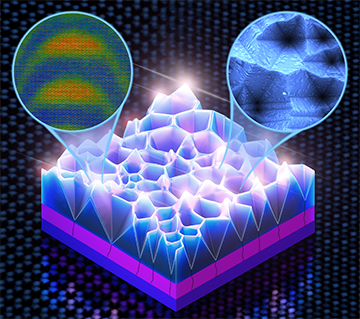
A new method of indium-rich quantum dot fabrication has been demonstrated by making use of intrinsic defects in LED materials. [Image: SMART/courtesy of G. Choo]
Indium gallium nitride (InGaN) LEDs emit copious amounts of green, blue and ultraviolet light, but they are notoriously inefficient at producing yellow, orange and red light. Thus, in devices that require the full spectrum of visible light, InGaN diodes must hide behind phosphors.
Now researchers from Singapore and the United States have demonstrated a way to generate longer-wavelength light from the intrinsic defects in the InGaN material (ACS Photon., doi: 10.1021/acsphotonics.1c01009). The team grew indium-rich quantum dots on these defects and measured the red light coming from these tiny spots.
The new method raises the possibility of future CMOS-compatible LEDs that give off the full spectrum of visible light—without the need for phosphors that generate excess heat and shorten the diodes’ lifespan.
Peaks and “V-pits”
The team from the Singapore-MIT Alliance for Research and Technology (SMART), a collaboration between the Massachusetts Institute of Technology, USA, and two Singapore universities, noted that previous efforts to create full-spectrum InGaN diodes incorporated patterned substrates, which added additional manufacturing complexity and higher costs.
However, the semiconductor material naturally contains dislocations in its crystal structure. When the InGaN is grown by chemical vapor deposition on a silicon substrate (with a buffer layer of aluminum gallium nitride between the two), the defects coalesce into nanoscale V-pits—randomly randomly scattered peaks and valleys that, under the microscope, look like a cross between mountain ranges and the surface of a sponge. On the peaks between the pits, indium-rich quantum dots spontaneously form, and these dots are the spots that efficiently radiate red light.
Accidental discovery
According to lead author Jing-Yang Chung and principal investigator Silvija Gradeček, both of SMART and the National University of Singapore (NUS), the scientists recognized that the textured surface of V-pits resembled pre-patterned structures demonstrated previously and they exploited this fact. “The observation of additional crystal defects that further enhances the luminescence was an accidental discovery, however,” they said in a press release accompanying the work.
The indium-rich quantum dots are roughly 10 nm in size, so to study and understand both their structural and optical properties, the researchers had to make high-spatial-resolution measurements. Chung and Gradeček said they and their colleagues prepared the samples for electron microscopy, taking care to ensure that they were as pristine as possible, with minimal amorphization and contaminants. They performed correlative optical and elemental spectroscopy mapping at both MIT and NUS.
“Pushing the emitting color of the quantum dots to longer wavelengths is of high interest,” Chung and Gradeček said. “That will involve further increase of the indium concentration within the quantum dots.” This approach, the pair suggested, could allow white light to be “generated from just this architecture alone,” as different-colored light from different parts of the structure could be combined.
“Fabrication of LEDs based on our structures is similar to conventional LED fabrication,” according to Chung and Gradeček. “So once the structures are optimized and tested, these can be incorporated into a product.”
